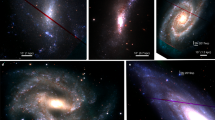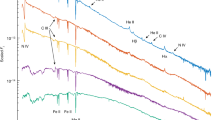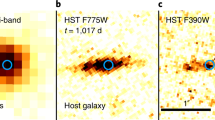Abstract
Neutrino bursts from the supernova SN1987A have been reported1–3 which provide qualitatively new information as to the time interval between the core collapse and the optical flaring of the supernova up to about 6 mag4. The interval that we take as three hours1,2 imposes conditions on the radius of the progenitor star and the energetics of the explosion. As for the brightness and its time change, the relatively less bright visual magnitude at the plateau in the light curve during the initial eight days or so (refs 5, 29) as well. The subsequent light curve after eight days is quite unique; the bolometric luminosity increases until ∼65 days (ref. 29) but thereafter it seems to level off gradually (J. Walsh and R. Stathakis, personal communication; M.A. Dopita, personal communication). To maintain the bolometric luminosity of the star means that certain conditions should be imposed on the energy source. By computing the propagation of shock wave, the subsequent expansion of ejected matter and the optical light curve, we find that the early light curve can be accounted for by the diffusive release of energy deposited by the shock wave, that the progenitor's radius should be as small as ∼(1–3) × 1012 cm, and that the explosion energy per unit mass should be relatively large, ∼(2–3)× 1051 erg for the ejected matter of 7–10 M⊙. The light curve after eight days is well reproduced by using a model with constant energy input. The energy input may be due to the activity of an embedded pulsar. The light curves calculated by invoking the radioactive decay of 56Ni and 56Co are less satisfactory in accounting for the nearly flat portion observed after 65 days. Supposing Sk–69 202 is the progenitor of SN1987A13,14, its explosion energy should be >2×l051erg; this suggests that a prompt shock mechanism forms a neutron star.
This is a preview of subscription content, access via your institution
Access options
Subscribe to this journal
Receive 51 print issues and online access
$199.00 per year
only $3.90 per issue
Buy this article
- Purchase on Springer Link
- Instant access to full article PDF
Prices may be subject to local taxes which are calculated during checkout
Similar content being viewed by others
References
1. Hirata, K. et al (Kamiokande-II collaboration) Phys. Rev. Lett. 58, 1490-1493 (1987). 2. Bionta et al. Phys. Rev. Lett. 58, 1494-1496 (1987). 3. Castagnoli, C. et al. IAU Ore. No. 4323 (1987). 4. McNaught, R. H. IAU Circ. No. 4316 (1987). 5. Cristiani, S. et al. Astr. Astrophys. 177, L5-L8 (1987). 6. Nomoto, K. & Hashimoto, M. Prog. Part. Nucl. Phys. 17,267–285 (1986); Proc. Japan–France Seminar on Chemical Evolution of Galaxies with Active Star Formation, Sci. Rep. Tohoku Univ. 7 (ed. Takakubo, K.) 259–276 (Tohoku Univ., 1987); Proc. Bethe Conf. Supernovae, Physics Report (ed. Brown, G. E.) (North–Holland, in the press). 7. Yahil, A., Johnston, M. D. & Burrows, A. J. comput. Phys. (in the press). 8. Pomraning, G. C. Astrophvs. J. 266, 841–847 (1983). 9. Hershkowitz, S., Linder, E. & Wagoner, R. V. Astrophys. J. 303, 800–809 (1986). 10. Ebisuzaki, T., Hanawa, T. & Sugimoto, D. Publs astr. Soc. Jap. 35, 551–566 (1984). 11. Ebisuzaki, T. & Nomoto, K. Astrophys. J. 305, L67–70 (1986). 12. Huebner, W., Merts, A., Magee, M. Jr & Argo, M. Los Alamos Sci. Lab. Rep. No. LA6760M (1977). 13. Panagia, N. et al. Astr. Astrophys. 177, L25–L28 (1987). 14. Kirshner, R., Sonneborn, G., Crenshaw, D. M. & Nassiopoulos, G. E. Astrophys. J. (in the press). 15. Woosley, S. E., Pinto, P. A., Martin, P. G. & Weaver, T. A. Astrophys. J. (in the press). 16. Hillebrandt, W., Hoflich, P., Truran, J. W. & Weiss, A. Nature 327, 597–600 (1987). (in the press). 17. Arnett, W. D. Astrophys. J. (submitted). 18. West, R. M., Lauberts, A., Jorgensen, H. E. & Schuster, H. E. Astr. Astrophys. Ill, L1–L3 (1987). 19. Suntzeff, N. et al. IAU Circ. No. 4328 (1987). 20. Bodenheimer, P. & Ostriker, J. P. Astrophys. J. 181, 465–471 (1974). 21. Ostriker, J. P. Nature 327, 287–288 (1987). 22. Weaver, T. A., Axelrod, T. A. & Woosley, S. E. Type I Supernovae (ed. Wheeler, J. C.) 113–154 (University of Texas, Austin, 1987). 23. McCray, R., Shull, J. M. & Sutherland, P. Astrophys. J. 317, L73–L77 (1987). 24. Sato, H. Prog, theor. Phys. (submitted). 25. Arnett, W. D. Astrophys. J. 253, 785–797 (1982). 26. Woosley, S. E., Pinto, & Ensman, L. Astrophys. J. (submitted). 27. Humphreys, R. M. & Davidson, K. Astrophys. J. 232, 409–420 (1987). 28. Itoh, H., Hayakawa, S., Masai, K. & Nomoto, K. Publs Astr. Soc. J. 39, No. 3 (1987). 29. Menzies, J. M. et al. Astr. Astrophys. (in the press). 30. Gaffet, B. Astrophys. J. 216, 852 (1978).
Author information
Authors and Affiliations
Rights and permissions
About this article
Cite this article
Shigeyama, T., Nomoto, K., Hashimoto, M. et al. Light-curve models for supernova SN1987A in the Large Magellanic Cloud. Nature 328, 320–323 (1987). https://doi.org/10.1038/328320a0
Received:
Accepted:
Issue Date:
DOI: https://doi.org/10.1038/328320a0
This article is cited by
-
Light elements synthesized in the He-layer and the H-rich envelope of a type II supernova, II, —Influence of initial chemical compositions—
Earth, Planets and Space (2014)
-
Light elements synthesized in the He-layer and the H-rich envelope of a type II supernova—Influence of the adopted neutrino emission model—
Earth, Planets and Space (2000)
-
The unusual supernova 1987A
Astrophysics and Space Science (1988)
-
An estimation of the energy radiated by supernova 1987A
Astrophysics and Space Science (1988)
Comments
By submitting a comment you agree to abide by our Terms and Community Guidelines. If you find something abusive or that does not comply with our terms or guidelines please flag it as inappropriate.



